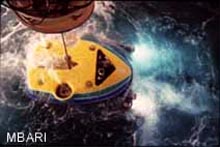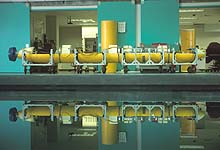
The remotely operated vehicle (ROV) Tiburon, designed and built by the Monterey Bay Aquarium Research Institute (MBARI), is a state-of-the-art platform for exploring the deep sea to depths of 4 km. The vehicle is equipped with cameras, lights, manipulator arms, in situ sensors, and other specialized sampling devices that allow Tiburon to serve as scientists' undersea eyes, ears, and hands. (Image courtesy MBARI)
Role of Technology in Ocean Exploration
Marcia McNutt
President and Chief Executive Officer
Monterey Bay Aquarium Research Institute
The desire to explore is fundamental to the human spirit. It is what inspires mountaineers to risk frostbite in scaling the highest peaks or malaria in penetrating the deepest jungles. The perils of any terrestrial exploration pale in comparison, however, to the challenges encountered in exploring the deep sea. The vast majority of ocean depths are bone chillingly cold (<2 degrees C), completely dark, and have ambient pressures equivalent to the weight of hundreds of atmospheres. Exploration of the deep sea, then, is impossible without a substantial investment in technology.
To understand how difficult it is to study the oceans, it is instructive to compare ocean exploration to space exploration, an area in which the United States has already invested heavily and reaped substantial rewards in new knowledge regarding the fundamental structure and history of the universe. People cannot live in space or in the oceans without substantial life-support systems. For that reason, manned exploration of both environs is costly and dangerous. Fortunately, advances in computers, control systems, and robotics have allowed a shift in recent decades from manned to unmanned missions. This trend will undoubtedly continue as we seek to go deeper, either into space or the deep ocean realm.

The autonomous underwater vehicle (AUV) Dorado, shown here reflected in MBARI's test tank, is a relatively inexpensive platform for surveying the deep sea. (Image courtesy of MBARI) Click image for larger view.
Once an exploration platform has been engineered for human occupancy, the principal concerns become power and communications. In both of these areas, space exploration has a substantial advantage over ocean research. Solar panels are capable of powering most interplanetary voyages, but sunlight does not penetrate beyond the uppermost regions of the ocean. Space is virtually transparent to the transmission of electromagnetic energy, while the oceans are opaque to this energy.
In dealing with these issues, oceanographers have developed two fundamentally different types of unmanned platforms and instrument packages. Tethered systems are connected either to a ship or shore via a cable, which is capable of bringing power to the undersea system and transmitting data both ways. Such systems have less stringent requirements for on-board artificial intelligence, since the cable effectively connects them remotely to the human brains of the operators.
In contrast, autonomous systems typically have no physical connection to the surface or shore, and, at best, intermittent communication with people via acoustic transmissions or satellite relay. Such systems must supply their own power, typically through some type of battery, because supplying oxygen for internal combustion engines is problematic in the deep sea. Nuclear power is also an option, but so costly and rife with environmental concerns that it has not been implemented within the civilian community.
Clearly, autonomous packages must be quite sophisticated in their control systems, especially if they are mobile. They must be able to execute a preprogrammed mission, store the information collected, and be intelligent enough to avoid failure modes (e.g., colliding with obstacles, running out of power before returning the information to shore). Despite the necessary sophistication, autonomous packages are, in general, less expensive than either manned submersibles or tethered vehicles because they can be smaller and lighter, and because the lack of human occupants makes catastrophic loss an acceptable risk.

The Environmental Sample Processor (ESP) is an in situ sensor designed and built by MBARI to probe the ocean's microorganisms. (Image courtesy MBARI) Click image for larger view.
The rise in popularity of autonomous vehicles as platforms for deep-sea study has gone hand-in-hand with the development of in situ instrumentation to sense the physical, chemical, and biological state of the ocean. The future trend will be to send data, rather than samples, back to shore by repackaging laboratory analyses so that they can be performed autonomously underwater. Not only is this a desirable feature for reducing costs and increasing real-time knowledge of the ocean's condition, such capabilities will be essential for future exploration of extraterrestrial oceans, such as the one believed to lie beneath the icy surface of Europa, one of Jupiter's moons.
The Monterey Bay Aquarium Research Institute (MBARI) is proud to be a leader in the development and operation of tethered and autonomous underwater platforms, as well as novel instrument packages for exploring the deep sea. A key to MBARI's success is its organizational culture, which builds partnerships among scientists exploring the ocean, engineers providing the enabling tools, marine-operations personnel who make each exploration successful, and data-management professionals who ensure that the fruits of exploration are widely available.
Sign up for the Ocean Explorer E-mail Update List.















